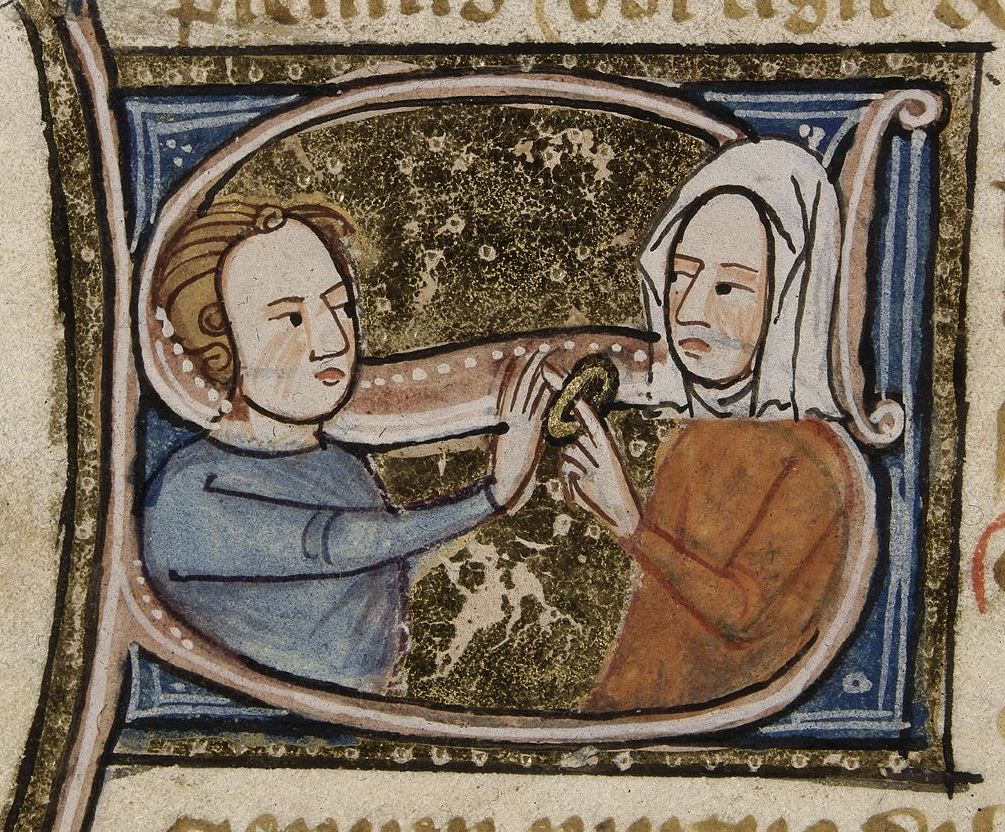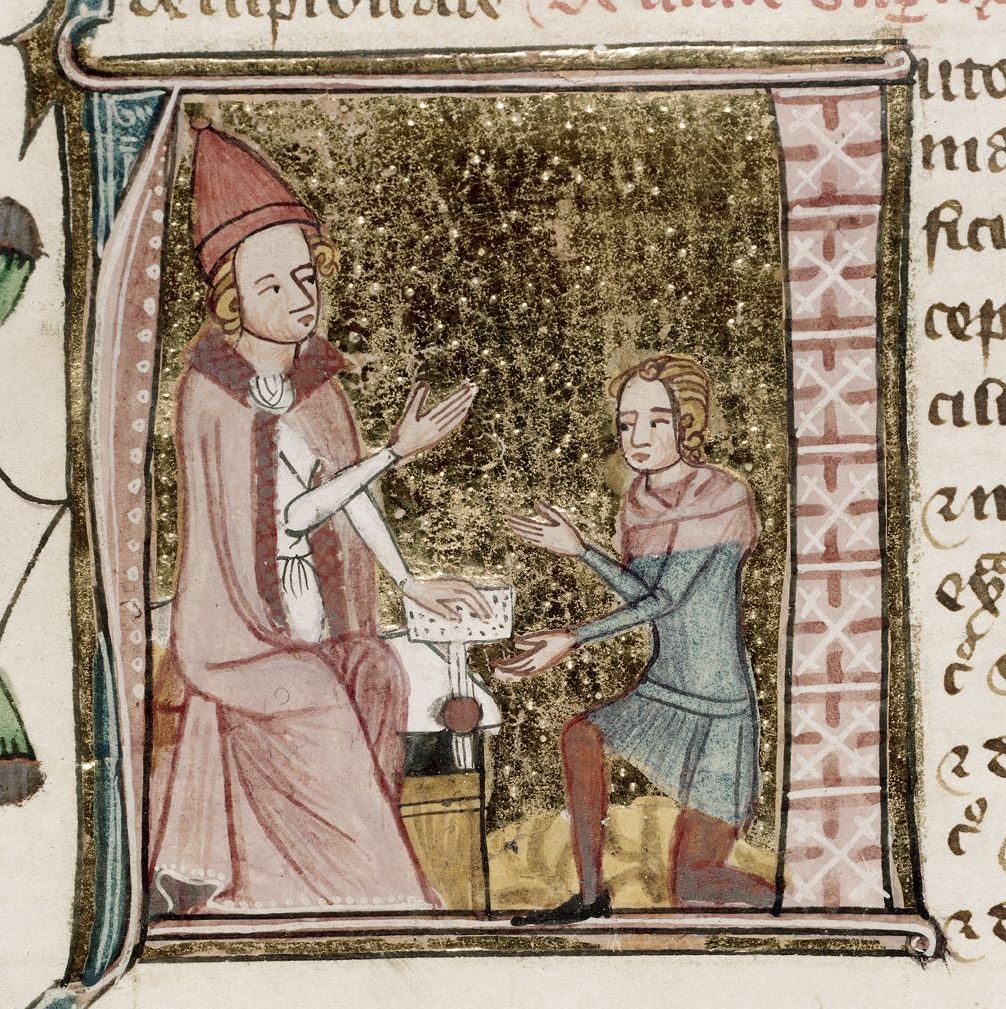In 1482, an Englishwoman named Margaret Singleton begged leniency from the Pope, having broken her vow of chastity. Margaret claimed that she had married her husband because she feared that ‘under the stimulus of the flesh she might give way to temptation.’ So, she argued, the marriage was ‘for the lesser peril of her soul’ – a vow broken in wedlock was preferable to extramarital sex. She simply didn’t trust herself to resist Robert Singleton’s charms.

Her plea is reported in a papal letter which grants absolution to Margaret and her husband. The couple had petitioned the Pope, that he should remove, or absolve, their sin: the Catholic church taught that the papacy had the authority to prescribe penitential acts which, once performed, rescued the sinner from damnation. The clergy did this too, for more minor offences, but the greatest sins required the greatest authority.
The Singletons had chalked up a long list of rather troubling transgressions. The first of these was that the couple had married and had at least one child despite the fact that Margaret – ‘with a woman’s levity’ – had taken a vow of chastity. In the late fifteenth century, it was not uncommon for English widows to vow chastity without taking the accompanying monastic vows of poverty and obedience. These women, known as vowesses, typically read their vow before a bishop who bestowed upon them a ring, a mantle and often a habit or a veil. They promised nothing but to ‘live stably‘ in the chaste life they professed, but this promise was then non-negotiable. To break the vow was a serious crime.
Margaret explained her broken vow as the least sinful concession to a desire which she could not subdue or contain. But she did not explain why, after marrying Robert Singleton and bearing his child, she continued to wear her vowess’ habit. The fact that the wedding was conducted ‘per verba de presenti’ – a verbal contract with no official solemnisation – suggests that maybe the sex, and the pregnancy, predated the marriage. Or perhaps there was no priest available who was ignorant of Margaret’s vow and so could be fooled into conducting an unlawful wedding.
The story gets worse. The papal letter goes on to state that ‘in the meantime the said Robert Singleton… overcome by the weakness of the flesh, has, at the instigation of the author of all evil, carnally known a certain girl, Margaret’s daughter by her first husband and the said Robert Singleton’s step-daughter.’ This is especially startling as incest allegations were, at this time, extremely rare. Margaret’s first husband is named as Robert Bothe, but further research reveals that this is untrue. Before Bothe, Margaret was married to William Balderston, and it was Balderston who fathered her two daughters, Joan and Isabel. It is unclear which of these was ‘carnally known’ by Robert Singleton, but both were almost certainly adults by 1482. Joan herself was widowed by 1462, and was to be widowed again before she vowed herself in 1488. It is, of course, possible that the ‘girl’ in question was neither Joan nor Isabel but was indeed an underage daughter of Margaret and Robert Bothe of whom no record survives. It is also unclear, and, for ecclesiastical purposes, irrelevant, whether the sex was consensual, though there is no mention of penance for the daughter. Additionally, there is no way of deducing what was behind the united front presented by the Singletons, or how Margaret felt about what had occurred.
The letter adds ‘that the said Robert and Margaret deeply grieve for the said excesses, and that the incest of adultery committed by the former is secret’ – a curious choice of words, since the matter would surely not have remained a secret for long after going through the ecclesiastical courts. There is no explanation for why the Singletons sought absolution and jeopardised secrecy if they were not under pressure because the secret was already out. The Pope didn’t seem to mind these inconsistencies, however: both were absolved equally with minor penances and that, as far as the Church was concerned, was the case closed.
The Singleton case, apparently so unjustly resolved, is an unusual one, and not only because of the incest which is mentioned as a virtual footnote. While there are other contemporary instances of failed vowesses, Margaret’s claims that she was powerless to resist ‘the stimulus of the flesh’ contrast sharply with the narratives presented by other married or widowed women who took similar vows. Margery Kempe, for example, described sexual intercourse as a duty joyfully relinquished once childbearing is done, and several continental matron-mystics shared her view. Margaret, on the other hand, appears to have found that a mystical union with Christ was not going to warm her toes in bed. The transition from wedded wife to sexless widow would not have been an easy or natural one for every vowess.
Other women who broke their vow justified themselves very differently from Margaret Singleton. The registers of the Apostolic Penitentiary record several such instances. The Apostolic Penitentiary was (and is) the highest office in the Catholic Church concerned with sin, for crimes which can only be absolved by the cardinal penitentiary on behalf of the Pope himself. Alice Cotton sought absolution there for breaking her vow, as well as dispensation to remain married, in 1498. She pled that she vowed in her grief less than thirty days after the death of her husband, implying that her judgement was clouded by her recent bereavement. Rogeria (also called Margery) Roper also appears in these volumes, requesting to be absolved of her vow and declared free to marry in 1492 and again in 1493. She argued that she had only vowed to escape overwhelming pressure to remarry. She claimed that certain magnates were endeavouring to persuade her with ‘plots, evil persuasions and threats’, and that they were ‘unceasingly pursuing her’ so that she was ‘greatly disturbed in spirit’ and feared for her life. She presented her decision to vow as a means to ensure her personal safety.

Another intriguing case involved Jane Pole, the daughter-in-law of Margaret Plantagenet, countess of Salisbury. Jane was widowed in the late 1520s, and vowed the day after her husband’s funeral. She nonetheless married William Barentyne in 1539. A legal case was brought before the London consistory court and the marriage was declared invalid. The Barentynes fought back. Like Alice Cotton, Jane claimed that she took the vow whilst overcome with grief, ‘in exceeding great heaviness and sorrow and almost besides herself’, and thus that she didn’t fully know what she was doing.
Jane also claimed that the countess Margaret and her son had pressured her into the vow, and that Montague ‘did earnestly instigate, persuade and procure’ her, even endeavouring to frighten her into it by telling her that she must vow ‘for a time to avoid suitors and other dangers.’ She emphasised that she had been told that she could vow temporarily, just as novices were not obliged to become nuns. The case was eventually solved at the intervention of the king by an Act of Parliament in 1543/4, which ruled in Jane’s favour. However, the legal wrangling continued even after Jane’s death, and the legitimacy of Jane’s and William Barantyne’s son’s birth was questioned as late as 1563.
To break a vow of chastity was transgressive, and there was always trouble of some sort as result. The justifications with which women defended themselves reveal factors which complicated their decision-making, such as bereavement and external pressure from interested parties. These excuses could have been genuine or simply convenient, but they were probably emphasised because they were more likely to have been greeted with sympathy. Margaret Singleton is the only known petitioner to refer to her own desire – arguably a bold move. In a society which prized chastity above all other female virtues, and a Church which taught that, without proper supervision, ‘the weaker sex’ were particularly prone to sexual perversion, for a woman to publicly acknowledge her own sexuality was extremely unusual. Of course, Margaret may have been lying: she may have been coerced by her husband, who appears to have been rather an unsavoury character to say the least, to cover further crimes on his part. Certainly the narrative as a whole doesn’t quite add up. Yet whether Margaret was more or less honest than her fellow vow-breakers, her explicit acknowledgement of her own sexual desire is remarkable, even refreshing.
 Laura Wood is a PhD candidate at Royal Holloway, University of London. She works on vowesses in the southern ecclesiastical province, 1450-1540. She tweets from @cooksferryqueen
Laura Wood is a PhD candidate at Royal Holloway, University of London. She works on vowesses in the southern ecclesiastical province, 1450-1540. She tweets from @cooksferryqueen

NOTCHES: (re)marks on the history of sexuality is licensed under a Creative Commons Attribution-NonCommercial-NoDerivatives 4.0 International License.
Based on a work at www.notchesblog.com.
For permission to publish any NOTCHES post in whole or in part please contact the editors at NotchesBlog@gmail.com





There’s definitely something fishy about their story, isn’t there? But it’s even more suspicious that they were forgiven. Somewhere there must be some papers to fill in the gaps. I hope someone finds them.